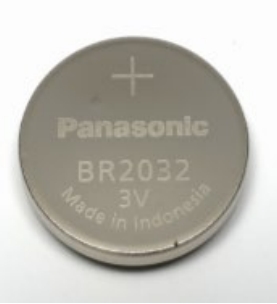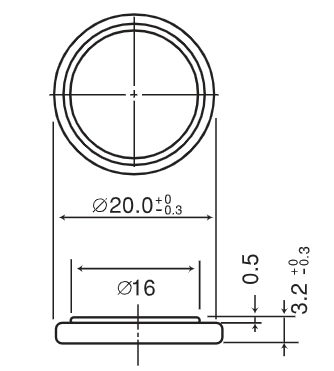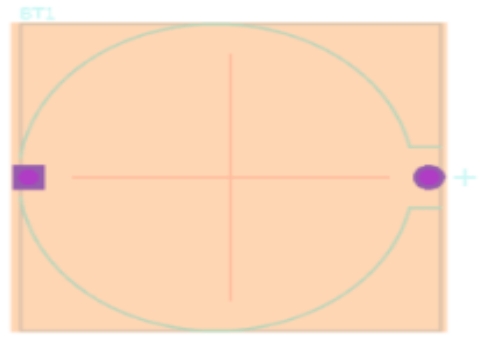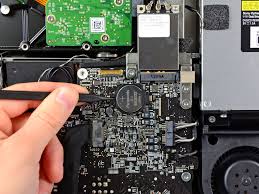The Panasonic BR2032 Battery: Features, Applications, and Specifications
2024/7/3 18:11:02
Views:
When it comes to small electronic devices, batteries are a crucial component, and among the many types available, the BR2032 and CR2032 are particularly popular. In this blog post, we'll take a deep dive into the BR2032 battery, discuss its specifications, compare it with the CR2032, and review the datasheet for the Panasonic BR2032.
What is a BR2032 Battery?

One kind of lithium coin cell battery is the BR2032 battery. It is extensively utilized in many tiny electronic gadgets, including medical equipment, watches, calculators, and key fobs. The BR2032 is a great option for applications requiring dependable and long-lasting power sources because of its high energy density and long shelf life.
Panasonic BR2032 Datasheet
Panasonic is a renowned manufacturer of high-quality batteries, and their BR2032 model is no exception. Below is a detailed overview of the Panasonic BR2032 datasheet for the Panasonic BR2032 battery.
Ⅰ Electrical Characteristics
- Nominal Voltage: 3V
- Nominal Capacity: 190 mAh (discharge current of 0.03 mA, end voltage 2.0V)
- Standard Discharge Current: 0.03 mA
- Maximum Continuous Discharge Current: 0.5 mA
- Maximum Pulse Discharge Current: 5 mA (15 seconds max)
Ⅱ Physical Characteristics
Size / Dimension: 20 mm diameter, 3.2 mm height(0.79Dia x 0.13 H 20.0mmx3.2mm)
Weight: 2.5 grams

BR2032 Dimensions
Ⅲ BR2032 Battery Pinout

- The battery is shown in a side view, resembling a flat, circular disc.
- The top surface of the battery is labeled as the "Positive Side (+)" and is highlighted with a red arrow pointing to it.
- The bottom edge of the battery is labeled as the "Negative Side (-)" and is highlighted with a black arrow pointing to it.
- The labels indicate the polarity of the battery, with the top side being positive and the bottom side being negative.
Ⅳ BR2032 Battery Symbol

- Top Line: The longest horizontal line, marked with a "+" sign, indicating the positive terminal.
- Middle Lines: Two shorter, parallel horizontal lines, representing the internal structure of the battery.
- Bottom Line: A horizontal line longer than the middle ones but shorter than the top line, marked with a "-" sign, indicating the negative terminal.
Ⅴ BR2032 Battery Footprint

The footprint design includes several key features:
- Shape and Dimensions: The footprint has a rectangular outline with a central circular area, indicating where the battery will be placed.
- Pads: There are two prominent pads for electrical connections. On the left side, there is a square purple pad, likely for the negative terminal. The positive terminal is indicated by a circular, purple pad on the right side.
- Placement Indicators: The central circular area is marked with a light green circle, likely representing the outer edge of the battery. In order to show where the placement center is, there are crosshairs in the center of the circle.
- Labels and References: The top-left corner has a label "ST1" which could be a reference designator for the footprint. There is a small light blue cross on the right side near the positive pad, possibly indicating the polarity or alignment for assembly.
The footprint ensures proper placement and soldering of the BR2032 battery on a printed circuit board (PCB).
Ⅵ Performance Characteristics
Operating Temperature Range: -30°C to +80°C
Storage Temperature Range: -30°C to +80°C
Self-Discharge Rate: Less than 1% per year at 20°C
Ⅶ Safety and Compliance
1. RoHS Compliant: Yes
RoHS (Restriction of Hazardous Substances) compliance indicates that the BR2032 battery is free from certain hazardous materials that are harmful to the environment and human health. This compliance ensures that the battery does not contain substances like lead, mercury, cadmium, hexavalent chromium, and certain flame retardants in amounts exceeding specified limits.
2. UL Certification: UL1642
UL1642 Certification pertains to the safety standards set by Underwriters Laboratories (UL) for lithium batteries. This certification confirms that the BR2032 battery meets the necessary safety requirements for electrical, thermal, and mechanical stress conditions. It ensures the battery's safety in terms of potential hazards like overheating, short circuits, and fire.
Ⅷ Datasheet PDF
Download the Panasonic - BSG BR2032 datasheets and manufacturer documentation.
Key Features
1. Long Shelf Life: BR2032 batteries are perfect for devices that are not used regularly because they may hold a charge for up to 10 years when stored properly.
2. Wide Operating Temperature Range: These batteries are reliable under a variety of climatic circumstances since they can operate efficiently in a wide temperature range, from -30°C to +80°C.
3. High Capacity: With a typical capacity of 190 mAh, BR2032 batteries provide a significant amount of power for their size, making them suitable for energy-demanding applications.
4. Stable Voltage: They maintain a stable voltage throughout their discharge cycle, ensuring consistent performance.
Applications of Panasonic BR2032 Battery
The Panasonic BR2032 battery is suitable for a wide range of applications due to its long shelf life, high capacity, and stable performance. Here are some detailed examples:
1. Medical Devices
- Glucose Meters: Reliable power source for accurate and consistent readings.
- Thermometers: Ensures long-lasting power for frequent temperature measurements.
- Hearing Aids: Provides stable power, ensuring consistent performance and reliability.
- Portable Medical Equipment: Ideal for devices that require dependable power in critical situations.
2. Backup Power
- CMOS Memory: Maintains system settings and real-time clock in computers and other electronic devices.
- Real-Time Clocks (RTC): Ensures the accurate keeping of time in various electronic devices, even when the main power is off.
3. Automotive Electronics
- Key Fobs: Powers remote keyless entry systems, providing reliable performance over long periods.
- Tire Pressure Monitoring Systems (TPMS): Essential for monitoring and maintaining correct tire pressure, enhancing vehicle safety.
- Car Alarms: Ensures consistent operation of alarm systems, crucial for vehicle security.
4. Remote Controls
- TV Remotes: Long-lasting power for frequently used remote controls.
- Garage Door Openers: Provides reliable operation for everyday use.
- Devices that manage climate, security, and lighting in a house are powered by home automation systems.
5. Industrial Instruments
- Measurement Equipment: Powers precision instruments used in various industrial applications.
- Sensors: Provides reliable power for environmental and security sensors.
- Data Loggers: Ensures consistent operation of devices that record data over time, important for monitoring and analysis.
6. Wearable Technology
- Fitness Trackers: Long-lasting power for devices that monitor physical activity and health metrics.
- Smartwatches: Ensures wearable technology operates dependably and offers a variety of functionality beyond keeping track of time.
7. Memory Backup Systems
- Servers: Ensures that critical system settings and configurations are maintained during power outages.
- Routers and Network Equipment: Keeps essential network settings intact, ensuring quick recovery after power interruptions.
8. Toys and Gadgets
- Electronic Toys: Provides long-lasting power for children's toys, ensuring hours of playtime.
- Small Gadgets: Ideal for small, portable electronic gadgets that require a compact and reliable power source.
Circuit of Panasonic BR2032 Battery

BR2032 Battery example in hotel circuit
This circuit uses a BR2032 battery to power a water level sensing and alert system. The operational amplifier processes the sensor signal, the microcontroller makes decisions based on this input, and the buzzer and LED provide audible and visual alerts when the water tank is full. This type of circuit can be used in hotel water systems to monitor and manage water levels effectively. This is a thorough explanation of each part and how it works.
Components
- BR2032 Battery (B1): Provides the 3V power supply for the circuit.
- PIC12F1572 Microcontroller (U2): Central processing unit that manages the sensor input and controls the output.
- Water Level Sensor (Probe Pins): Detects the water level and provides input to the microcontroller.
- MCP6411 (U1): Operational amplifier used to amplify the signal from the water level sensor.
- Transistor (Q1, 2N7002): Used to drive the buzzer.
- Buzzer (BZ1): Emits a sound when the tank is full.
- Resistors (R1-R7): Control current flow and set operating conditions for the components.
- Capacitors (C1-C2): Stabilize voltage supply and filter noise.
- LED Indicator (H2): Shows the status of the water level.
Circuit Functionality
1. Power Supply: The BR2032 battery provides 3V to the entire circuit.
2. Water Level Detection:
- The probe pins act as a water level sensor.
- When the water level reaches the sensor, it changes the input signal to the operational amplifier (U1).
- The operational amplifier processes this signal and sends it to the microcontroller (U2).
3. Microcontroller:
- The microcontroller receives the processed signal from the operational amplifier.
- It checks if the water level is full based on the input signal.
- When the tank is full, the transistor receives a high signal (Q1).
4. Buzzer Activation: The high signal from the microcontroller activates the transistor (Q1), which in turn drives the buzzer (BZ1) to emit a sound indicating the tank is full.
5. LED Indicator: An LED connected to the microcontroller (H2) can be used to visually indicate the tank's status.
Schematic Diagram Description
1. Power Connections:
- VDD (3V from the BR2032 battery) is supplied to all VDD pins on the microcontroller, operational amplifier, and other components.
- Ground connections are common for all components.
2. Sensor Input:
- The operational amplifier's input is connected to the water level sensor.
- The output of the operational amplifier connects to an input pin on the microcontroller.
3. Small-scale controller:
- Organizes, interprets, and regulates the signals coming from sensors.
- Pins RA0, RA4, and RA5 are used for input/output operations.
4. Circuit Buzzer:
- The transistor (Q1) acts as a switch for the buzzer.
- When the microcontroller sends a high signal, it turns on the transistor, completing the circuit and powering the buzzer.
5. Indicator LED:
- An LED connected to the microcontroller shows the status of the water level.
How to replace a BR2032 battery?
To replace a BR2032 battery, follow these detailed steps:
Tools You Will Need:
- Small screwdriver (if necessary)
- A new BR2032 battery
- Clean cloth or gloves (optional for handling the new battery)

Steps:
- Locate the Battery Compartment: Identify where the battery is located in your device. This could be on the back, side, or underside of the device. Common devices that use BR2032 batteries include watches, calculators, remote controls, and some small electronic devices.
- Set Up Your Work Area: Make sure the surface you'll be working on is tidy and level. This helps to avoid losing small screws or other parts.
- Open the Compartment: If the battery compartment has a cover, use the small screwdriver to carefully remove any screws. Some compartments might have a sliding cover or a snap-on lid that you can open with your fingernail or a small tool.
- Remove the Old Battery: The old BR2032 battery should be carefully removed. Keep an eye on the battery's orientation, focusing on the positive (+) and negative (-) sides. The positive side is typically marked and should be facing up in most devices.
- Clean the Compartment (Optional): If the battery compartment is dirty, use a clean cloth to wipe it out. This guarantees that the new battery will attach properly.
- Put the New Battery in: Take the New BR2032 Battery and put it in the compartment with the Old Battery in the same orientation. Make sure the positive (+) side is facing the same way it was before. Handle the new battery with clean hands or gloves to avoid transferring oils from your skin onto the battery, which can affect its performance.
- Close the Compartment: If required, put the battery compartment cover back on after replacing it. Make sure the cover is firmly in place to prevent the battery from shifting.
- Test the gadget: Using the new battery, turn on your gadget to make sure it is operating correctly. Verify that the battery is oriented correctly and that the compartment is closed properly if the gadget does not switch on.
Additional Tips:
- Safety: Always handle batteries with care. It is not appropriate to press the battery into the container..
- Disposal: Get rid of the outdated battery the right way. Instead of throwing it in the garbage, please take it to a battery-accepting recycling facility.
- Replacement: Verify that your battery is the right kind (BR2032). Using a different type could damage your device.
BR2032 vs. CR2032: Key Differences
The BR2032 and CR2032 are often compared due to their similar size and shape, but they have distinct differences that affect their performance and suitability for different applications.
Chemistry
The BR2032 uses Lithium/Carbon Monofluoride (Li/CFx) chemistry, which offers a longer shelf life and better performance at higher temperatures. For applications where durability and high-temperature performance are essential, this makes it especially appropriate. On the other hand, the CR2032 uses Lithium Manganese Dioxide (Li/MnO2) chemistry, which provides a higher initial discharge current. It is perfect for gadgets that need a brief energy boost because of this feature.
Shelf Life and Temperature Range
The BR2032 boasts a longer shelf life of up to 10 years and can operate effectively within a wide temperature range of -30°C to +80°C. It may be used for a lengthy period of time in a variety of climatic situations due to its wide operating temperature range and extended lifespan. In contrast, the CR2032 typically has a shelf life of around 5-7 years and operates effectively within a temperature range of -20°C to +60°C. While this is sufficient for many common applications, it may not be as versatile as the BR2032 in extreme conditions.
Applications
The BR2032 is ideal for devices that need a long-lasting, stable power source, such as medical devices, memory backup systems, and high-temperature environments. It is a dependable option for demanding applications due to its consistent performance and extended shelf life. Conversely, the CR2032 is better suited for devices that require a higher initial discharge current, such as LED lights, key fobs, and some electronic toys. Its ability to deliver quick bursts of energy makes it well-suited for applications where immediate power delivery is essential.
Summary
The chemistry and performance attributes of BR2032 and CR2032 batteries are where they diverge most. BR2032 uses Lithium/Carbon Monofluoride (Li/CFx) chemistry, which provides a longer shelf life and better performance at higher temperatures. CR2032 uses Lithium Manganese Dioxide (Li/MnO2) chemistry, offering a higher initial discharge current, suitable for devices requiring quick bursts of energy. BR2032 is ideal for long-lasting, stable power, while CR2032 is better for applications needing high initial current. You can choose the battery that best suits the requirements of your particular application by being aware of these important distinctions, guaranteeing optimum performance and dependability.
Common Queries Answered
1. How long does a BR2032 battery last?
A BR2032 battery can last up to 10 years when stored properly, thanks to its long shelf life. The actual lifespan in use depends on the device's power consumption. In low-drain devices like CMOS memory and remote controls, it can last several years. For more power-hungry applications, the lifespan will be shorter but still typically longer than other similar batteries.
2. Can I use a BR2032 battery instead of a CR2032?
Yes, you can often use a BR2032 battery instead of a CR2032, as they share the same size and voltage. However, consider the specific needs of your device. If it requires high initial discharge current, a CR2032 might be more suitable. For applications needing long-lasting, stable power, the BR2032 is a better choice.
3. Are BR2032 batteries rechargeable?
No, BR2032 batteries are not rechargeable. These are primary lithium batteries that are meant to be used just once, and they should be changed when they run out. For rechargeable options, you might consider lithium-ion or other rechargeable battery chemistries, but ensure compatibility with your device.
4. How do I dispose of BR2032 batteries?
Proper disposal of BR2032 batteries is important for environmental protection. Do not throw them in regular trash. Instead, deliver them to a facility that is specifically designed to recycle batteries, or drop them off at recycling centers, electronics retailers, or neighborhood hazardous trash collection events. Many retailers also offer battery recycling programs.
5. What is the operating temperature range of BR2032 batteries?
BR2032 batteries have an operational temperature range of -30°C to +80°C. This wide range ensures that the battery performs reliably in both extremely cold and hot conditions, making it suitable for various environments and applications.
6. What gadgets require batteries BR2032?
BR2032 batteries find application in numerous products, such as:
- Medical devices (glucose meters, thermometers, hearing aids)
- Backup power for CMOS memory and real-time clocks
- Electronics for cars (tire pressure monitoring systems, key fobs)
- Remote controls (TV remotes, garage door openers)
- Industrial instruments (measurement equipment, sensors)
- Wearable technology (fitness trackers, smartwatches)
- Memory backup systems (servers, routers)
- Toys and small electronic gadgets
7. Where can I buy BR2032 batteries?
BR2032 batteries are generally accessible and can be bought from a number of places, such as:
- Online retailers like Amazon, eBay, and specialized battery stores
- Electronics stores like Best Buy and RadioShack
- General retailers like Walmart and Target
- Pharmacies and hardware stores
- Directly from battery manufacturers' websites(icwhale.com)
8. How to test a BR2032 battery?
How to test a battery BR2032:
- Employ a Multimeter: Adjust the multimeter to detect DC voltage.
- Check the voltage by connecting the multimeter probes, positive to positive and negative to negative, to the battery connectors.
- Examine the voltage: The voltage of a fully charged BR2032 battery should be approximately 3 volts. If there is a noticeable decline in voltage, the battery might need to be changed.
9. Does use BR2032 batteries pose any safety risks?
BR2032 batteries are typically safe to use, however, there are a few things to keep in mind:
- Avoid cutting corners: Keep the positive and negative terminals from being directly connected.
- Keep out of direct sunlight: The battery may leak or explode as a result of excessive heat.
- Keep small children away: Because little batteries can choke small children, keep them out of reach.
10. How to store BR2032 batteries properly?
To store BR2032 batteries properly:
- Store them somewhere cold and dry; stay away from intense heat and humidity.
- Maintain in its original packaging: This shields the batteries from harm and stops unintentional short-circuiting.
- Stay out of the sun: Prolonged exposure to sunlight might cause the battery to degrade.
Related Information
-
-
Phone
+86 135 3401 3447 -
Whatsapp





